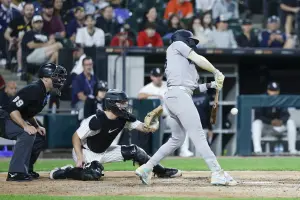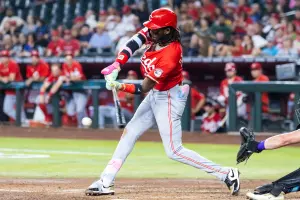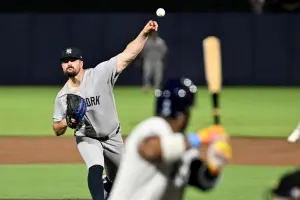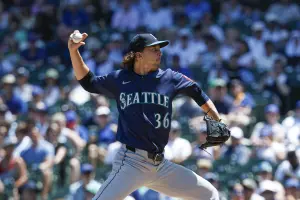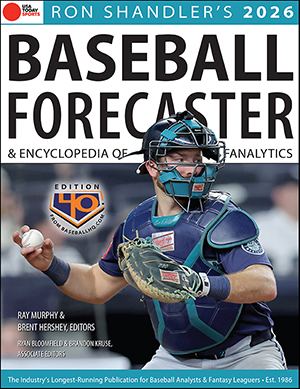
(*) F/F SPOTLIGHT: Adrian Gonzalez
NOTE: Our Facts/Flukes series has long been a staple in BaseballHQ.com's player performance analysis. It's the place where many of our metrics meet in one place to attempt to answer the question of whether a player's current performance is "real" or not. Each column examines five players at a time every Monday through Thursday.
Today, we debut a new Friday version, Facts/Flukes Spotlight, which will provide the same type of analysis, but focus on only one player per column. This concentrated approach will allow analysts to probe deeper at the whys of one player's performance and employ multiple metrics, tools and methods along the way.
We're excited about this new venture, and welcome your feedback on the concept in the comments area below.
The high-level view of Adrián González's (1B, LA) career path is fairly straightforward: he was an elite hitter at the tail end of the first decade of the 2000s, especially when adjusted for pitcher-friendly PETCO Park. Then, concurrent with his move from San Diego to Boston before the 2011 season, he underwent a shoulder surgery that has somewhat diminished his performance; certainly he has fallen out of the elite tier of first basemen. But with a hot start to 2014, we are left to wonder: is Adrián González reclaiming his elite status?
According to Gonzalez himself, his hot start does correlate with an improvement in the condition of that surgically-repaired shoulder. The key quotes:
Now, more than three years removed from the surgery, Gonzalez said of his shoulder, "It's looser."
"My finish is coming back," Gonzalez said. "It's something that's more mechanical than physical. If I can have a high finish and long finish like that, the ball will have more carry."
Rather than take Gonzalez at his word, let's see if we can find any evidence that would validate Gonzalez's self-evaluation.
History
As a baseline, here is Gonzalez's extended statistical profile, broken into three chunks: his pre-injury SD years, his post-injury BOS/LA years, and his first few weeks of 2014.
Year Tm AB R HR RBI BA OBA SLG OPS 5x5 ==== == === === == === === === === === === 2008 SD 616 103 36 119 279 361 510 871 $24 2009 SD 552 90 40 99 277 407 551 958 $22 2010 SD 591 87 31 101 298 393 511 904 $26 2011 BOS 630 108 27 117 338 410 548 957 $40 2012 2TM 629 75 18 108 299 344 463 806 $24 2013 LA 583 69 22 100 293 342 461 803 $24 2014 LA 80 14 5 17 288 356 563 918 $27
And here is the corresponding skills snapshot for the same three periods:
Year bb% ct% Eye HctX H% xBA G/L/F PX xPX HR/F BPV ==== === === ==== ==== === === ======== === === ==== === 2008 11% 77% 0.52 126 31% 280 43/20/37 147 153 21% 69 2009 18% 80% 1.09 134 28% 305 39/21/40 160 165 22% 107 2010 14% 81% 0.82 124 33% 286 39/21/39 138 151 16% 81 2011 11% 81% 0.62 129 38% 296 47/21/32 142 128 16% 85 2012 6% 83% 0.38 121 34% 279 40/24/36 111 134 10% 52 2013 7% 83% 0.48 124 32% 272 38/23/39 110 138 11% 59 2014 10% 73% 0.41 142 34% 296 41/22/37 193 159 23% 87
A few observations:
-
The 2011 season, Gonzalez's first in Boston and the one immediately following the shoulder surgery, is one that bears closer inspection as the bridge between the "two Gonzalezes." In terms of productivity (top chart), it was a strong season in line with his San Diego work, and in fact the most valuable stat line of his career. But the skills components (second chart) tell us that his 2011 was propped up by an outlier h% that masked the power loss; in fact the corresponding uptick in GB% and downturn of xPX are pretty clear indications that something was negatively affecting Gonzalez's swing that year. The shoulder surgery seems like an obvious limiting factor.
-
For the three years immediately following that shoulder surgery, Gonzalez's power metrics plateaued at that lower level, with a corresponding dip in xBA. In fact, his PX fell off even further, though xPX remained stable across those years and pointed to some potential recovery. But after 1800+ AB at that new established PX level, it was quite reasonable to consider this Gonzalez's new baseline. In fact, we reached that exact conclusion in a Fact/Fluke analysis from last August, where we said: (see his PlayerLink "News" tab for full writeup) "... the days of 30-plus homer seasons seems to be a thing of the past."
- This past offseason in the 2014 Baseball Forecaster, we latched onto the PX/xPX gap a little more optimistically and left the door open for some power recovery, offering this summation: "xPX suggests that there may yet be some latent power here, so pay for another carbon copy but don't be surprised by UP: 30 HR." Those "UP" projections are meant to be out-on-a-limb in nature, so we can't take full credit for these early signs that Gonzalez is delivering on that upside. (Besides, it's ridiculously early to declare victory on anything we projected this offseason.)
Bottom line: A more detailed look at Gonzalez's track record entering 2014 largely confirms our high-level view: the timing of the shoulder injury meshes nicely with Gonzalez's fall from elite status. There have been glimmers of hope for a recovery since then, but nothing sustained.
Hard-hit ball data
Next, let's take a deeper dive into Gonzalez's hard-hit ball data. One eye-catching tidbit in the above charts is that Gonzalez's HctX metric is essentially stable across all years in our chart, both pre- and post-surgery. Meanwhile, xPX shows a clear pre- vs. post-surgery change. Both metrics are rooted in hard-hit ball data. Is there something we can conclude from that?
Here is Gonzalez's hard-hit ball data over the same timeframe:
Year Tm Hard% Med% Soft% ==== == ===== ==== ===== 2008 SD 37% 53% 10% 2009 SD 37% 53% 10% 2010 SD 38% 49% 14% 2011 BOS 31% 50% 18% 2012 2TM 33% 50% 17% 2013 LA 36% 51% 13% 2014 LA 47% 36% 17%
In this light, those seemingly-inconsistent metrics start to make sense:
HctX pairs two metrics: hard-hit balls, and contact rate: we can see here that Gonzalez's HH% did indeed suffer post-surgery, but that he was compensating with increased contact rates (per the earlier charts).
Meanwhile, xPX focuses specifically on hard-hit line drives and fly balls, and Gonzalez has spent the past three years sneaking his HH% back toward pre-surgery San Diego levels. While maintaining a stable Med%, he has been quietly converting soft-hit balls into hard-hit ones. That would logically drive the xPX optimism, given it's dependence on hard-hit ball data in that formula.
Using the whole field
Another aspect of Gonzalez's profile at his peak was that he possessed some of the best opposite-field power in the game. It was that trait that was particularly attractive to the Red Sox when they acquired him, as they wanted Gonzalez to pepper the Green Monster with that opposite-field swing from the left side. What can we learn from the distribution of his power over our timeframe?
Year Tm TotHR OppHR %OppHR PullHR ==== === ===== ===== ====== ====== 2008 SD 36 15 42 21 2009 SD 40 22 55 18 2010 SD 31 13 42 18 2011 BOS 27 12 44 15 2012 2TM 18 7 39 11 2013 LA 22 4 18 18 2014 LA 5 2 40 3
The flip side of Gonzalez's opposite-field proclivity is that his pull-field HR output has remained rather stable; or at least it certainly hasn't declined to the same extent as his "oppo" power. This may be consistent with Gonzalez's self-diagnostic quote that his ability to extend into the finish of his swing drives his opposite-field power. The early returns in 2014 on that front are positive.
For instance, compare Gonzalez's spray chart on extra-base hits between 2013 and this April: 2013 doubles (triangles) and HR (diamonds) on the left, 2014 on the right: (spray charts courtesy of BaseballSavant.com)
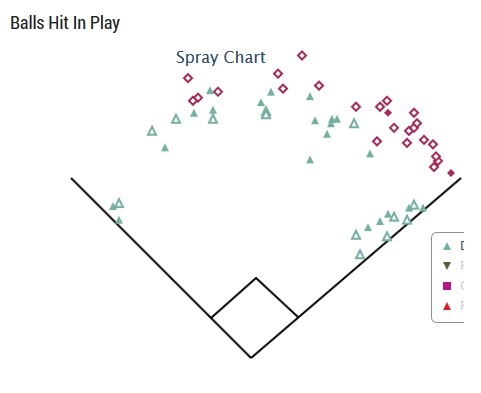 |
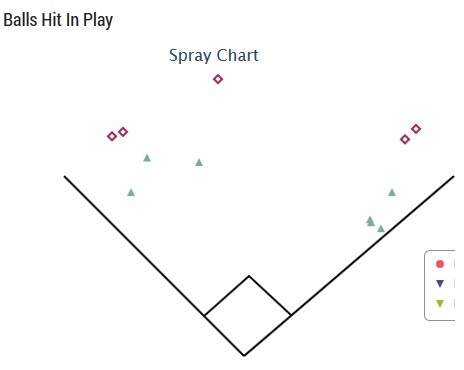 |
It's awfully early to draw conclusions, but the 2014 chart (right) is clearly more balanced around the field.
It seems like there is a lot to like about this reincarnation of Gonzalez. But before we get carried away, let's explore some caveats.
Caveats
There are three main areas that support a more skeptical view of Gonzalez's hot start:
First: sample size. This should go without saying, as with all analysis conducted at this early juncture: Gonzalez is still shy of 100 AB in 2014. The data set that we are looking at here has to be considered flimsy to say the least.
Second: the quality of opposition. Related to sample size, there is always the possibility that Gonzalez is just taking advantage of a soft slate of early opponents. Without performing rigorous analysis on that concept (which would be pointless because we can't be sure who's good and who's not at this point... sample size issues form a vicious circle!), we can point out that Gonzalez's 2014 HRs have come against a group of pitchers who would be characterized as fairly pedestrian, and/or have been struggling in their own right this April:
Third: sustainability. Even if Gonzalez is in fact healthier right now than he has been in the past few years, and that is a driver of his hot start, the big question remains... can he keep it up? Gonzalez's shoulder feels good today, but will it feel worse tomorrow? The recent case of Ryan Zimmerman (3B, WAS) illustrates this point: After early-season struggles last year with a shoulder injury that affected him both at the plate and in the field, Zimmerman took off in the warmer weather and had a great second half that looked like a springboard into 2014. But this spring, Zimmerman's shoulder problems were back in full force. That's not to say that Zimmerman and Gonzalez have comparable shoulder problems, but in general, the concept of "I feel good" can be a somewhat transient one. For further evidence, look at Gonzalez's xPX split from 2013: 151 in 1st half, 126 in 2nd half. Did his shoulder "tighten up" under the wear and tear of a full season? Should we expect that again this year?
Conclusion
The caveats above are too strong to allow a full-throated endorsement of what Gonzalez has done to date. With the calendar not even turned to May yet, it's difficult to take any performance at face value, even when that performance has prior support ("once you display a skill, you own it"). But it's safe to note: if Adrián González were going to suddenly and completely regain his peak form from his San Diego years, it would look exactly like what we are seeing from him right now.
There’s more where this came from: Check out a BaseballHQ.com subscription, which gives you complete access to the site through the entire 2014 season.


